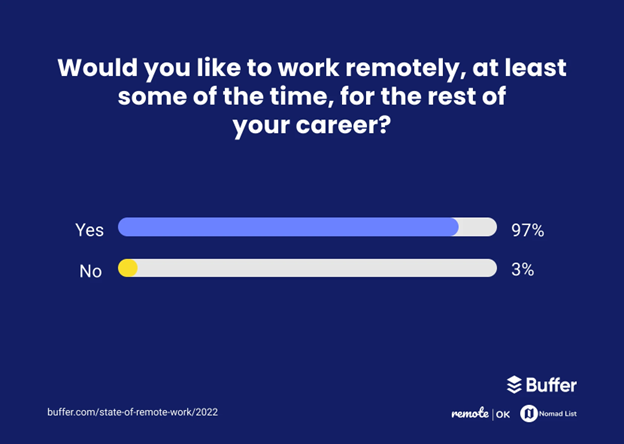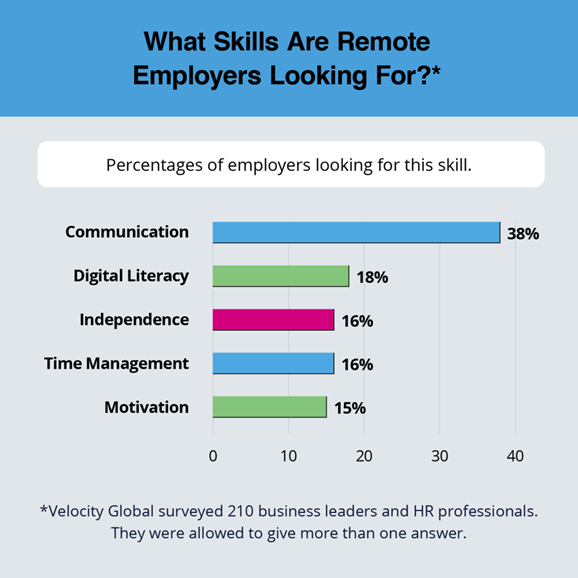Losing the remote control is a fear of every TV enthusiast. And losing control is also a fear of marketers who lead remote teams—especially teams that they will need, in time, to scale.
There are certainly obstacles for remote managers that can militate against good leadership and make scaling up trickier than it should be. This article will cover how those obstacles can be tackled.
We'll start by looking at the growth in popularity of remote work for marketers and the characteristics of good virtual team leadership. Then we'll determine how you can get your remote control back. And, no, it won't be down the back of the sofa.
Remote Marketing Work: Why So Popular?
Marketing lends itself well to the remote environment. Why? Because there are types of marketing that really only require a laptop, an Internet connection, and a brain. That means it can be done pretty much wherever the worker wants to be.
Content marketing is a perfect example. If you've got something relevant and original to say that will engage the reader and promote the product, there's no need to be present in the office.
Then it's just a matter of the organization's ensuring that the right gear is in place to deal with remote working, such as computers and connectivity, and there are the right nuts and bolts at the admin end, such as communication solutions, payroll software, collaboration tools, etc.
Remote working is popular. Employees love it.

Source: Buffer
Employers have mixed feelings about remote working. There's a residual sentiment that "If you're not in the office, you're not working." Some 38% of managers in 2020 said they felt that remote workers give lower productivity than office workers, for instance.
Whether that is down to trust issues, facing up to limitations in the model, or doubt in their own ability to lead remote teams is an interesting question.
Five Tips for Good Remote Team Leadership
A remote marketing team leader needs to keep several elements top of mind:
- Communication. Make an effort to connect and be mindful of your team members' needs. Has one of them gone a little quiet? Reach out and give support.
- Clarity. Be super-clear on goals. When you're not there in the room with team members, they may find it more difficult to seek elucidation.
- Cohesion. Make the team want to interact with each other.
Those are the primary principles that all team leaders need to espouse, but with remote teams it just takes a little more intentionality because things don't get brought up or dealt with in passing.
It is crucial to ensure that the team has the right communication solutions in place to foster effective collaboration and coordination, such as robust videoconferencing tools, project management software, and instant messaging platforms.
Here's how you can implement those points to keep your remote marketing team in tip-top shape.
1. Select your team wisely
Good remote team leadership starts right at the beginning of the employment cycle. If you know you're hiring for a remote post, think carefully about the person you want to fill it.
Communication skills are an absolute must. What else?

Source: velocityglobal.com
Remote work is great for the type of people who can wrap their head around a task and then apply themselves to its completion. But the person who needs spoon-feeding and micro-managing...? Maybe not so much.
Be especially vigilant during the probation period; it's your chance to right a selection wrong. Once the wrong team members have got their feet well and truly under the table, it becomes much harder to do anything about it.
When you hire the right employees, it becomes easier to scale up when the time comes.
You may want to hire freelance developers who have experience working remotely if you need to scale up your team quickly. They can help marketers complete projects on time and achieve their business goals.
2. Give structure
Remote marketing teams need robust frameworks to maintain healthy communication. The remote work environment doesn't include the casual project discussions that a traditional office provides to adjacent desk-dwellers. So, you need to put an alternative in place to lead remote teams well.
The usual response is to slather on multiple meeting requirements. But that can be smothering to some virtual environment employees.
Don't go down that path. Have catch-up sessions (either by videoconference or virtual phone system) by all means, but regular meetings for meetings' sake can irritate and prove counter-productive.
Keep team meetings focused on the clear goals you need to meet. Don't necessarily corral the entire team; involve people for whom the topic is relevant. Otherwise, you'll have a team of people wasting their time, doing the minimum, and quite literally dialing it in.
Scaling and leading remote teams effectively can be challenging for marketers, but with the right tools, they can achieve their goals. For teams using Jira for project management, for example, Tableau Connector is a fantastic tool that can help marketers understand data, stay organized, and collaborate efficiently with their remote teams.
3. Show trust
Trust comes easier to some than to others. Some are happy to give a longer leash; others prefer keeping their staff on a tight lead. Yes, trust has to be earned; but, where warranted, trust is crucial. Without it, morale and mental well-being can suffer.
Of course, you can recalibrate trust depending on what pans out. Someone can go through a poor performance patch, in which case you can give a little less leeway until the issue is resolved, using an HR management system to monitor and steer an employee back onto the right path.
If a team member is unreachable for an extended period of time, it's important to maintain trust and give them the benefit of the doubt before assuming the worst. A quick phone search or reaching out to their emergency contact can help clarify the situation.
4. Team-build
You don't want to get the team together in a dreary meeting just for the sake of it, so how do you achieve cohesion? By organizing some team-building activities. Doing so not only encourages bonding between colleagues but also enables managers to see how people work in a team.
You don't have to ship everyone off to the middle of nowhere and test their survival skills. That old cliché is why the phrase "team-building" strikes fear into the hearts of many employees. You could certainly arrange a physical get-together for remote workers if that's feasible, but there are many activities you can do online.
For example, you could hold virtual social events, whether it's a drinks session or a fun quiz. Get some decent prizes together and think about running some entertaining competitions. Or you could book the whole team for an online escape room challenge.
Those types of bonding can help your remote teams to get to know one another in a more relaxed setting, which will definitely help them to collaborate more effectively at work.
5. Show support
Good managers know when their team is not smashing it, and they can identify the reasons for it. Great managers go to the relevant employees and offer assistance.
Of course, scaling up can require special support to established team members who are perhaps struggling with new workloads or to large numbers of new employees going through the teething stage. Pay attention to training to make sure everyone is up to scratch. If necessary, rewrite the rules: Use a training manual template to help.
But support is also about managers' themselves seeking help if they need it. It's easy to think managers should always have the answers, but it's often the case that they don't. That can be especially true for remote working because it's a relatively new phenomenon with fewer tried-and-tested routines to ensure success. A manager feeling a little uncertain needs support from further up.
* * *
If you're a good leader, you can be a good remote leader. It's basically the same set of skills, only tweaked to deal with distance. Show your connection skills, be clear, be supportive, and be trusting where it's warranted. That's the way you get a proficient and enthusiastic remote marketing team. It also makes it much easier to communicate your marketing team's value. Then, when it's the right time to scale, you've got the building blocks of a cohesive marketing team right there, ready to flex and expand.
More Resources on Managing Remote Marketing Teams
Remote Marketing Teams: Benefits, Challenges, and Five Tools to Keep Them Synced
Trusting Remote Workers: The New Normal [Infographic]
Five Tips for Effective Communication With Distributed Teams




